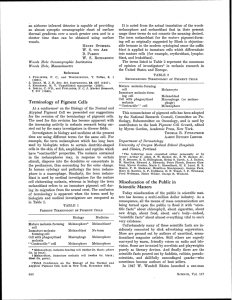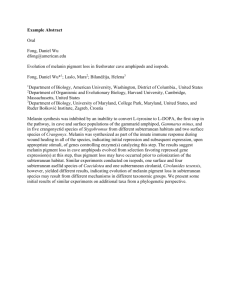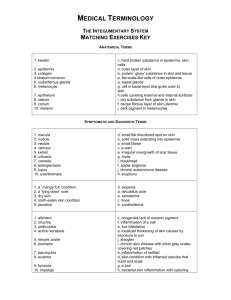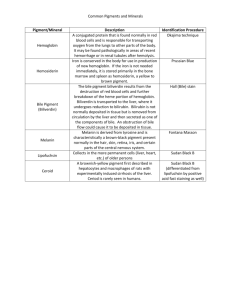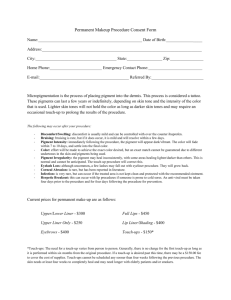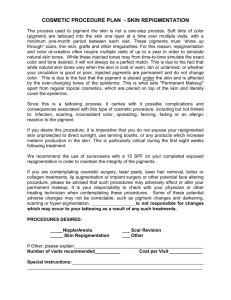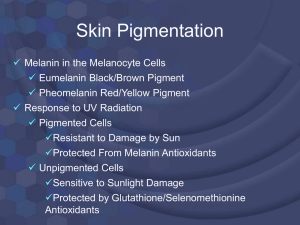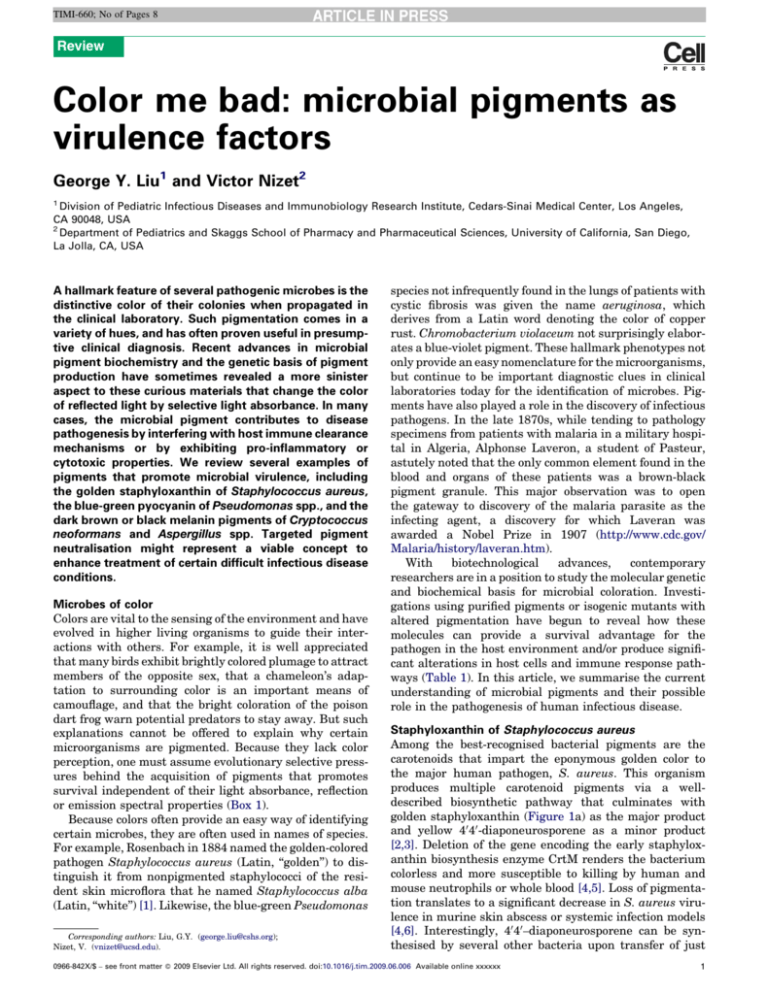
TIMI-660; No of Pages 8
Review
Color me bad: microbial pigments as
virulence factors
George Y. Liu1 and Victor Nizet2
1
Division of Pediatric Infectious Diseases and Immunobiology Research Institute, Cedars-Sinai Medical Center, Los Angeles,
CA 90048, USA
2
Department of Pediatrics and Skaggs School of Pharmacy and Pharmaceutical Sciences, University of California, San Diego,
La Jolla, CA, USA
A hallmark feature of several pathogenic microbes is the
distinctive color of their colonies when propagated in
the clinical laboratory. Such pigmentation comes in a
variety of hues, and has often proven useful in presumptive clinical diagnosis. Recent advances in microbial
pigment biochemistry and the genetic basis of pigment
production have sometimes revealed a more sinister
aspect to these curious materials that change the color
of reflected light by selective light absorbance. In many
cases, the microbial pigment contributes to disease
pathogenesis by interfering with host immune clearance
mechanisms or by exhibiting pro-inflammatory or
cytotoxic properties. We review several examples of
pigments that promote microbial virulence, including
the golden staphyloxanthin of Staphylococcus aureus,
the blue-green pyocyanin of Pseudomonas spp., and the
dark brown or black melanin pigments of Cryptococcus
neoformans and Aspergillus spp. Targeted pigment
neutralisation might represent a viable concept to
enhance treatment of certain difficult infectious disease
conditions.
Microbes of color
Colors are vital to the sensing of the environment and have
evolved in higher living organisms to guide their interactions with others. For example, it is well appreciated
that many birds exhibit brightly colored plumage to attract
members of the opposite sex, that a chameleon’s adaptation to surrounding color is an important means of
camouflage, and that the bright coloration of the poison
dart frog warn potential predators to stay away. But such
explanations cannot be offered to explain why certain
microorganisms are pigmented. Because they lack color
perception, one must assume evolutionary selective pressures behind the acquisition of pigments that promotes
survival independent of their light absorbance, reflection
or emission spectral properties (Box 1).
Because colors often provide an easy way of identifying
certain microbes, they are often used in names of species.
For example, Rosenbach in 1884 named the golden-colored
pathogen Staphylococcus aureus (Latin, ‘‘golden’’) to distinguish it from nonpigmented staphylococci of the resident skin microflora that he named Staphylococcus alba
(Latin, ‘‘white’’) [1]. Likewise, the blue-green Pseudomonas
Corresponding authors: Liu, G.Y. (george.liu@cshs.org);
Nizet, V. (vnizet@ucsd.edu).
species not infrequently found in the lungs of patients with
cystic fibrosis was given the name aeruginosa, which
derives from a Latin word denoting the color of copper
rust. Chromobacterium violaceum not surprisingly elaborates a blue-violet pigment. These hallmark phenotypes not
only provide an easy nomenclature for the microorganisms,
but continue to be important diagnostic clues in clinical
laboratories today for the identification of microbes. Pigments have also played a role in the discovery of infectious
pathogens. In the late 1870s, while tending to pathology
specimens from patients with malaria in a military hospital in Algeria, Alphonse Laveron, a student of Pasteur,
astutely noted that the only common element found in the
blood and organs of these patients was a brown-black
pigment granule. This major observation was to open
the gateway to discovery of the malaria parasite as the
infecting agent, a discovery for which Laveran was
awarded a Nobel Prize in 1907 (http://www.cdc.gov/
Malaria/history/laveran.htm).
With
biotechnological
advances,
contemporary
researchers are in a position to study the molecular genetic
and biochemical basis for microbial coloration. Investigations using purified pigments or isogenic mutants with
altered pigmentation have begun to reveal how these
molecules can provide a survival advantage for the
pathogen in the host environment and/or produce significant alterations in host cells and immune response pathways (Table 1). In this article, we summarise the current
understanding of microbial pigments and their possible
role in the pathogenesis of human infectious disease.
Staphyloxanthin of Staphylococcus aureus
Among the best-recognised bacterial pigments are the
carotenoids that impart the eponymous golden color to
the major human pathogen, S. aureus. This organism
produces multiple carotenoid pigments via a welldescribed biosynthetic pathway that culminates with
golden staphyloxanthin (Figure 1a) as the major product
and yellow 40 40 -diaponeurosporene as a minor product
[2,3]. Deletion of the gene encoding the early staphyloxanthin biosynthesis enzyme CrtM renders the bacterium
colorless and more susceptible to killing by human and
mouse neutrophils or whole blood [4,5]. Loss of pigmentation translates to a significant decrease in S. aureus virulence in murine skin abscess or systemic infection models
[4,6]. Interestingly, 40 40 –diaponeurosporene can be synthesised by several other bacteria upon transfer of just
0966-842X/$ – see front matter ß 2009 Elsevier Ltd. All rights reserved. doi:10.1016/j.tim.2009.06.006 Available online xxxxxx
1
TIMI-660; No of Pages 8
Review
Trends in Microbiology Vol.xxx No.x
Box 1. Some natural functions of microbial pigments
Some natural functions proposed for microbial pigments are given
below, with an example reference:
Protection against ultraviolet radiation [30]
Protection against oxidants [4]
Protection against extremes of heat and cold [88]
Protection against natural antimicrobial compounds produced by
other microbes [19]
Antimicrobial activities against other microbes [37]
Acquisition of nutrients, such as iron [21]
Acquisition of energy by photosynthesis (e.g. cyanobacteria) [89]
two S. aureus genes, crtM and crtN [2]. When these genes
are introduced into group A Streptococcus, the now pigmented tranformants produce large lesions in a mouseskin infection model, demonstrating that S. aureus
carotenoids are both necessary and sufficient to promote
bacterial pathogenicity [4].
Staphyloxanthin consists of a C30 polyene carbon backbone with alternating single and double bonds typical of
carotenoid pigments (Figure 1a); these alternating bonds
are able to absorb excess energy from reactive oxygen
species (ROS) [7]. Compared with the wild-type parent
strain, a nonpigmented S. aureus mutant is much more
susceptible to killing by hydrogen peroxide, superoxide
radical, hydroxyl radical, hypochloride and singlet oxygen
[4,5]. Consistent with an antioxidant role, the survival
advantage conferred by the S. aureus pigment is lost upon
infectious challenge of chronic granulomatous disease
(CGD) mice or in killing assays using blood of CGD patients
with deficient oxidative burst function [4].
Melanin in Cryptococcus neoformans and Aspergillus
fumigatus
Melanin is a pigment commonly found in organisms across
many kingdoms (reviewed in Gomez and Nosanchuk [8],
Jacobson, [9] and Nosanchuk and Casadevall [10]). Melanins are structurally diverse high molecular pigments
made of oxidative polymerisation involving quinones,
which can assume three oxidation states. Studies of the
paramagnetic properties of melanin identified strong electron-spin resonance signal, which is interpreted as evidence for the presence of stabilised free radicals in
biological systems. Thus, melanin can act as a trap for
unpaired electrons and has the ability to stabilise potentially harmful unpaired electrons such as those from ROS
[11]. A normal component of human skin and hair, melanin
is also found to coat the surface of two important fungal
pathogens, Cryptococcus neoformans and Aspergillus fumigatus. Recent mutagenesis studies have confirmed a virulence function of melanin production in these two agents of
severe opportunistic infection in immunocompromised
patients.
C. neoformans is an encapsulated yeast-like fungus that
produces a brown or black melanin pigment by conversion
of diphenols or homogentisic acid [12] (Figure 1g); this
coloration can be used for rapid identification of colonies
on cornmeal agar, a medium commonly used in yeast
isolation [13]. C. neoformans deficient in melanin production are less invasive and survive poorly in the spleen,
liver or brain of infected animals [14,15]. This diminished
virulence correlates to a reduced ability of melanindeficient mutants to resist phagocytic killing in vitro
[16]. Melanin production impedes phagocytosis of encapsulated C. neoformans by macrophages in vitro and in a
murine lung infection model [16,17]. Melanin also interferes with the action and efficacy of endogenous antimicrobial peptides and pharmacologic antifungal agents
against C. neoformans. The negatively charged pigment
neutralised the activity of neutrophil defensin and other
cationic antimicrobial peptides [18], and bound avidly to
amphotericin B and caspofungin [19], two front-line drugs
used in the treatment of severe fungal infection. Lastly, a
ferric iron reduction property of C. neoformans melanin,
converting Fe3+ to Fe2+, could theoretically facilitate ferrous iron uptake through a specific transport system and
improve in vivo survival [20,21].
Melanin pigment production might also modulate the
inflammatory response to cryptococcal infection. When
compared with a weakly pigmented strain, infection with
Table 1. Potential virulence functions of microbial pigments
Pigment
Staphyloxanthin
Chemistry
Carotenoid
Color
Golden
Human pathogens
Staphylococcus aureus
Virulence functions
Antioxidant, detoxify ROS [4,5]
Pyocyanin
Phenazine-derived
zwitterion
Blue–green
Pseudomonas spp.
Melanin
Polyacetylene or
polypyrrine
polymers
Dark-brown,
black
Porphyrin
Heteromacrocycle
Black
Cryptococcus neoformans,
Aspergillus spp.,
Wangiella dermatitidis,
Sporothrix schenckii,
Burkholderia cepacia
Porphyromonas gingivalis
Cytotoxicity [36,37,39]
Neutrophil apoptosis [50]
Ciliary dysmotility [43]
Proinflammatory [49]
Antioxidant [11,30,31,32]
Antiphagocytic [16]
Block antimicrobials [18,19]
Granadaene
Orange–red
Streptococcus agalactiae
Antioxidant, detoxify ROS [64]
Purple
Chromobacterium violaceum
Antioxidant, detoxify ROS [69]
Prodigiosin
Ornithine rhamnopolyene
Rearranged
pyrrolidone
scaffold
Linear tripyrrole
Red
Serratia marcescens
Immunosuppressant [79]
Hemozoin
b-hematin aggregates
Brown–black
Plasmodium spp.
Detoxification [53]
Macrophage suppression [56]
Pro–inflammatory [58]
Violacein
2
Antioxidant, detoxify ROS [74]
TIMI-660; No of Pages 8
Review
Trends in Microbiology
Vol.xxx No.x
Figure 1. Diverse chemical structures of pigments expressed by microbial pathogens. (a) Staphyloxanthin, Staphylococcus aureus; (b) hematin in malarial hemazoin or the
Porphyromonas gingivalis pigment; (c) violacein, Chromobacterium violaceum; (d) granadaene, Group B Streptococcus; (e) pyocyanin, Pseudomonas aeruginosa; (f)
prodigiosin, Serratia marcescens; (g) melanin, Cryptococcus neoformans.
a heavily melanised strain of C. neoformans inhibited the
afferent phase of the T-cell immune response as evidenced
by diminished tumour necrosis factor (TNF)-a production
by alveolar macrophages and decreased expansion of cryptococcus-specific lymphocytes [22]. Further evidence of
pigment-mediated inflammatory gene suppression comes
from analysis of central nervous system (CNS) injury and
cytokine responses following direct intracerebral instillation of an albino C. neoformans strain versus a companion
melanotic revertant. The pigmented strain produced a
lethal infection and massive CNS tissue damage accompanied by minimal cytokine response. Conversely, the
melanin-deficient strain never produced a fatal infection,
and triggered enhanced CNS levels of mRNA transcripts
for interleukin (IL)–12, TNF-a, IL-1b, interferon (IFN)-g
and inducible nitric oxide synthase (iNOS) [23] Mouse
immunisation studies using cryptococcal melanin have
shown that, despite its amorphic polymeric nature, the
fungal pigment can stimulate the immune system to generate specific antibodies [24].
A. fumigatus is a filamentous fungus that elaborates a
melanin-like substance during its conidial stage of growth.
Survival of conidia within the host is a crucial first step in
Aspergillus infection. Conidia from an A. fumigatus
mutant strain lacking pigmentation are more susceptible
to killing by oxidants and by human monocytes in vitro,
and showed reduced virulence in a murine infectious challenge model [25]. Electron microscopic analysis demonstrated that nonpigmented conidia sustained more
extensive structural damage within monocytes compared
with wild-type pigmented conidia [25]. Targeted mutation
of the A. fumigatus alb1 gene, encoding a polyketide
synthase in the dihydroxynaphthalene-melanin pathway,
results in an albino phenotype lacking the bluish-green
conidial pigment [26]. The nonpigmented mutant was
found to be much more susceptible to complement C3
deposition and neutrophil phagocytosis, and was significantly attenuated in a murine intravenous challenge mode
[27].
Additional evidence for a contribution of melanin pigments to virulence has been provided in studies of other
fungal and bacterial pathogens. Elimination of melanin
production by the infrequently encountered dematiaceous
fungus Wangiella dermatitidis is associated with diminished ability to produce invasive hyphal forms, increased
susceptibility to neutrophil killing, and virulence in mouse
models of infection [28,29]. Non-melanised conidial
mutants of the thermally dimorphic fungal pathogen Sporothrix schenckii show increased susceptibility to killing by
ROS, reactive nitrogen species or UV light [30]. Proteus
mirabilis, a Gram-negative bacterial agent of human urinary tract infections, produces a melanin pigment that can
act as a free-radical trap [31]. A melanin pigment isolated
from an epidemic strain of Burkholderia cepacia also possesses antioxidant properties that can attenuate macrophage superoxide production [32].
Pyocyanin of Pseudomonas aeruginosa
P. aeruginosa is a leading bacterial pathogen in hospital
settings and patients who are immunocompromised as a
3
TIMI-660; No of Pages 8
Review
result of neutropenia, burns or cystic fibrosis. Many P.
aeruginosa strains elaborate the blue-green phenazinederived pigment pyocyanin (Figure 1e), which can impart
a greenish hue to the sputum of cystic fibrosis patients with
chronic lung infection [33]. In contrast to the antioxidant
features of staphyloxanthin and bacterial melanin pigments, P. aeruginosa pyocyanin exhibits a paradoxical
pro-oxidant property. A zwitterion that can easily penetrate biological membranes, pyocyanin can directly accept
electrons from reducing agents such as NADPH and
reduced glutathione, then transfer the electrons to oxygen
to generate ROS such as hydrogen peroxide and singlet
oxygen [34] at the expense of host antioxidant systems
such as glutathione and catalase [35]. P. aeruginosa
mutants lacking pyocyanin are greatly attenuated in both
acute and chronic mouse models of lung infection [36], and
the remarkable toxic properties of the pigment can be
demonstrated to extend to a broad array of target organisms including bacteria, yeast, insects, nematodes and
plants [36–39] Inhibition of cellular respiration is clearly
one of the important mechanisms of pyocyanin toxicity to
bacterial or eukaryotic cells [40,41].
The fundamental ability of pyocyanin to alter the redox
cycle and increase oxidative stress appears central to its
diverse detrimental effects on host cells. For example,
pyocyanin disrupts Ca2+ homeostasis in human airway
epithelial cells by oxidant-dependent increases in inositol
trisphosphate and the abnormal release of Ca2+ from
intracellular stores. Because Ca2+ is important for regulating ion transport, mucus secretion and ciliary beat, these
alterations probably have important ramification for P.
aeruginosa lung infections [42]. The pathway of vacuolar
ATPase vesicle transport and protein targeting appears
particularly sensitive to pyocyanin action, as revealed in a
yeast-mutant library screen [41]. Pyocyanin inhibition of
ATPase could directly explain many of its toxicities including ciliary dysmotility [43], disruption of calcium
homeostasis [42] and diminished apical membrane localisation of the cystic fibrosis transmembrane conductance
regulator (CFTR) [44]. Other potentially toxic effects of
pyocyanin include perturbance of cellular respiration, epidermal cell growth inhibition, prostacyclin release from
lung endothelial cells and altered balance of proteaseantiprotease activity in the cystic fibrosis lung [45].
Many ROS exert a direct effect on NF-kB and other
signaling pathways to boost inflammatory cytokine
secretion [46,47]. The pro-oxidant effect of pyocyanin can
thus augment such innate immune response circuits [48].
For example, pyocyanin increases the release of the neutrophil chemokine IL-8 from lung epithelial cells and
upregulates the expression of the neutrophil receptor
intracellular adhesion molecule (ICAM)-1 both in vitro
and in vivo; these proinflammatory effects were blocked
by treatment with antioxidants [48,49]. In neutrophils,
pyocyanin induces a sustained increase in ROS and subsequent decrease in intracellular cAMP, which triggers a
time- and concentration-dependent acceleration of apoptosis [50]. As confirmed in studies using wild type and
isogenic pyocyanin-deficient mutant P. aeruginosa, pigment-dependent acceleration of neutrophil apoptosis and
diminished release of neutrophil chemokines might
4
Trends in Microbiology Vol.xxx No.x
represent an immune suppression mechanism of the
pathogen [51].
Hemozoin of the malaria parasite
Malaria parasites, including the human pathogens Plasmodium falciparum, P. vivax, P. malariae and P. ovale,
accumulate a brown pigment during infection known as
hemozoin [52]. In its strictest sense the pigment is not a
plasmodial product, but rather the byproduct of heme
detoxification [53] (Figure 1b). There exist many theories
as to how hemozoin is made, be it by some host processes or
specific plasmodial detoxification enzyme [54]. Hemozoin
has many functions that could contribute to Plasmodium
virulence and importantly, several antimalarial drugs including chloroquine work by targeting this heme detoxification/hemozoin synthesis pathway.
The hemozoin pigment appears to exert mixed effects on
the host immune system. Ingestion of hemozoin released
during schizont rupture by phagocytes has been shown to
lead to depression of phagocytosis and oxidative burst,
probably as a result of iron intoxication as removal of
the labile iron fraction from pigment reduces pigment
toxicity [55]. Hemozoin and/or products bound by the pigment also decrease expression of MHC class II antigen,
CD54 and CD11c in human monocytes, thereby affecting
antigen presentation [56] and blocking differentiation and
maturation of human monocyte-derived dendritic cells
[57]. Conversely, purified hemozoin activates macrophages
to produce pro-inflammatory cytokines, chemokines and
nitric oxide [58], which together are thought to contribute
to many of the systemic symptoms of malaria. Initial study
of this phenomenon linked hemozoin activity to the TLR9
immune activation pathway [59]. Subsequent work has
shown that hemozoin itself is inert, as nuclease treatment
abolished proinflammatory functions, indicating that the
pigment serves as a carrier for plasmodial DNA, which
itself is important in activating the host cytokine response
[60].
Granadaene of Group B Streptococcus
Group B Streptococcus (GBS), the leading etiologic cause of
severe neonatal bacterial infection, expresses an orangered pigment that was initially thought to be a carotenoid
because its signature triple peak absorbance pattern
[61,62]. However a more recent report deduced the pigment structure to be an ornithine rhamnopolyene with 12
conjugated double bonds, dubbed granadaene [63]
(Figure 1d). GBS pigment has been shown to enhance
GBS survival within macrophages [64], and a study of
isogenic pigmented versus nonpigmented GBS showed
preferential survival of the pigmented GBS in systemic
infection models [64]. Expression of the pigment is invariably linked to expression of another well-known GBS
virulence factor, the pore-forming b–hemolysin/cytolysin,
through a single genetic locus known as the cyl operon
[65,66].
Violacein from Chromobacterium violaceum
Violacein is a deep violet pigment produced by Chromobacterium violaceum, an occasional agent of fatal septicemia in humans [67]. Oxidation and coupling of two
TIMI-660; No of Pages 8
Review
molecules of L-tryptophan by the VioA to VioE enzymes
generate the rearranged pyrrolidone-containing scaffold of
the final pigment [68] (Figure 1c). Violacein has been
demonstrated to possess strong antioxidant properties,
and it can protect lipid membranes from peroxidation
caused by hydroxyl radicals [69]. Investigation of violacein
as a chemotherapeutic agent reveal its capacity to induce
apoptosis of leukocyte cell lines [70], and it is conceivable
that this property could play a role in immune evasion
during severe human infections. Finally, violacein has
potent antimicrobial activity against many bacteria and
protozoa [71]. Hence, secretion of this pigment might
protect against protozoal predation [72] and promote survival of C. violaceum in the environment.
Iron porphyrin of Porphyromonas gingivalis
The Gram-negative rod-shaped anaerobic bacterium Porphyromonas gingivalis is implicated in the pathogenesis of
certain forms of periodontal disease. Arginine- and lysinespecific gingipain proteases of P. gingivalis degrade hemoglobin to release iron(III) protoporphyrin IX (Figure 1b),
which is dimerised to form the micro-oxo bis-haem-containing black pigment of the organism [73]. This pigment can
then act as a buffer for P. gingivalis against killing by ROS
generated by neutrophils [74].
Antimicrobial therapy based on pigment inhibition
Because information is available on the biosynthetic
pathways underlying pigment generation in several
pathogenic species, the pigments themselves become
logical targets for virulence factor-based therapeutic
interventions. For example, the first committed step in
staphyloxanthin biosynthesis, catalyzed by the CrtM
enzyme, involves the head-to-head condensation of two
molecules of farnesyl diphosphate to produce the C30
species, presqualene diphosphate [5]. This reaction
resembles a key step used in human cholesterol biosynthesis, catalyzed by squalene synthetase (SQS). Solution
of the S. aureus CrtM crystal structure revealed active site
similarities and it was found that several SQS inhibitors
developed in the context of cholesterol lowing activity also
inhibited staphylococcal pigmentation [6]. One such
inhibitor, a phosphonosulfonate, was shown to be effective
in rendering S. aureus susceptible to ROS and neutrophil
killing, and was effective at reducing levels of the
pathogen by 98% in a murine systemic infection model
[6]. Theoretical advantages of this therapeutic approach
would lie in specificity, because the drug would not exert
unwanted effects on the normal microflora, and reduced
selective pressure for resistance, because the drug only
exerts its killing effect in the disease context of an
activated host immune response [4,6].
Novel approaches to treatment of cryptococcal infection
by inhibition of melanin production have been explored.
The systemic herbicide glyphosphate depletes C. neoformans melanin levels and prolongs host survival in an
experimental mouse model of cryptococcosis [75]. Treatment of C. neoformans-infected mice with monoclonal
antibodies to melanin reduced the fungal burden 100-fold
and improved survival following lethal challenge [76].
Because melanin also binds to amphotericin B and caspo-
Trends in Microbiology
Vol.xxx No.x
fungin, synergistic use of a melanin inhibitor could further
improve efficacy of these major antifungal drugs [19].
Microbial pigments as pharmacologic agents
The reddish-pink linear trypyrrole pigment prodigiosin
(Figure 1f) is produced by Serratia marcesens, an agent
of nosocomial infections of the urinary tract and wounds.
Prodigiosin has cytotoxic activity against numerous cancer
cell lines [77,78] and an immunosuppressive effect on T
cells, blocking IL-2 dependent proliferation through inhibition of IL-2-Ra expression [79]. In animal studies, prodigiosin blocks tumor metastasis, delays onset of
autoimmune diabetes and arthritis, and improves survival
in patients with heart transplant and graft-versus-host
disease [78,79]. Violacein extracted from C. violaceum is
effective against multiple cancer cells including uveal
melanoma, colorectal cancer, leukemia and lymphoma
cells in culture [70,80,81].
Synthetic melanin and melanin derived from grapes
have been shown to downregulate pro-inflammatory cytokine production in the presence of human blood monocytes
and in a rat model of adjuvant-induced inflammatory
disease respectively. [82,83]. Likewise, a few carotenoids
have been shown to activate the steroid receptor RAR and
RXR pathways to contribute directly to immune suppression [84]. Whether melanins and carotenoids isolated from
microbes have immunosuppressive properties remains to
be discovered.
Finally, to engineer natural products most suitable for
human consumption, researchers have begun to develop
recombinant microorganisms through engineering novel
biosynthetic pathways by (i) the combination of compatible
genes from different genomes into functional clusters and
(ii) the further evolution of new enzyme functions of these
genes via experimental mutagenesis, recombination and
selection [85,86].
Concluding remarks and future directions
Color in many animals warns of impending danger. From
the evidence summarised in this review, it would not be too
farfetched to say that pigmentation elaborated by certain
microbial species provides a warning of enhanced pathogenic potential. Although phylogenetic diversity of pigmented microbial species and the chemical diversity of the
pigments themselves might preclude a single unifying
hypothesis for their evolution and persistence, the most
common virulence-associated theme identified among
microbial pigments is resistance against ROS. The ability
of many pigments to stabilise ROS might be inherently
linked to the ability of these compounds to confer color
sensorium. We postulate that most pigments evolved
initially as a mechanism to combat environmental ROS,
but over time, these compounds were adapted to serve
divergent functions.
Pigmentation might contribute to virulence by allowing
a given microbe to evade host immune killing or by provoking inflammatory damage to cells and tissues. The danger
of pigmented pathogens might be further heightened in
patients with particular immunodeficiencies. For example,
patients with CGD harbor mutations in NADPH oxidase
resulting in weak phagocyte oxidative burst function; these
5
TIMI-660; No of Pages 8
Review
Box 2. Unanswered questions and future directions
Does the structural similarity of certain pigments across kingdoms
allow bacteria to modulate host cellular functions or engage in
molecular mimicry? Do these properties have important implication for human diseases?
Many pigments confer resistance to reactive oxygen species
(ROS). Because ROS promote inflammation, does the quenching
of ROS lead to a reduced inflammatory state? If so, can this action
promote microbial colonisation or infection?
Many of the pigment biosynthetic pathways generate a spectrum
of compounds with potentially diverse functions. What are these
functions, and can the microbe regulate synthesis of specific
product subsets for use under different environmental conditions?
The fact that some of the biosynthetic pathways involve a great
number of catalytic steps and thus metabolic expenditure
suggests that pigments are very important. Because such a
sophisticated pathway must evolve over time, it is likely that
intermediate products of the pathway are important or were once
important. How do microbes piece together complex pigment
biosynthetic pathways and what are the evolutionary pressures
that shape assembly of the final pathway?
How can a better knowledge of pigment properties and their
routes of biosynthesis inform an approach to drug discovery and
optimisation, including engineering of novel agents?
There are many more pigments in the microbial world for which
the natural functions or virulence functions remain unexplored.
individuals suffer chronic deep-seated infections with several pigmented microorganisms such as S. aureus, Aspergillus spp., S. marcescens and B. cepacia atop the list of
etiologic agents [87], perhaps as a result of effective
neutralisation of all residual ROS.
Further understanding of the biological properties of
microbial pigments will not only enrich our instinctual
curiosity about colors, but also provide a scientific basis
for therapeutic disarming of the pathogens or for borrowing these multifunctional molecules in pharmacologic
applications (Box 2).
Disclosures
The authors are each on the scientific advisory board of the
biotechnology company Auricx Pharmaceuticals, Inc.
Acknowledgements
Our research on S. aureus and GBS pigments was supported by NIH
grants AIO7432 (GYL) and HD051796 (VN), a Burroughs–Wellcome
Career Award (GYL) and an American Heart Association Established
Investigator Award (VN).
References
1 Rosenbach, F.J. (1884) Wund-Infections-Krankheiten des Menschen.
Bergmann, (Wiesbaden)
2 Wieland, B. et al. (1994) Genetic and biochemical analyses of the
biosynthesis of the yellow carotenoid 4,40 -diaponeurosporene of
Staphylococcus aureus. J Bacteriol 176, 7719–7726
3 Pelz, A. et al. (2005) Structure and biosynthesis of staphyloxanthin
from Staphylococcus aureus. J Biol Chem 280, 32493–32498
4 Liu, G.Y. et al. (2005) Staphylococcus aureus golden pigment impairs
neutrophil killing and promotes virulence through its antioxidant
activity. J Exp Med 202, 209–215
5 Clauditz, A. et al. (2006) Staphyloxanthin plays a role in the fitness of
Staphylococcus aureus and its ability to cope with oxidative stress.
Infect Immun 74, 4950–4953
6 Liu, C.I. et al. (2008) A cholesterol biosynthesis inhibitor blocks
Staphylococcus aureus virulence. Science 319, 1391–1394
6
Trends in Microbiology Vol.xxx No.x
7 El-Agamey, A. et al. (2004) Carotenoid radical chemistry and
antioxidant/pro-oxidant properties. Arch Biochem Biophys 430, 37–48
8 Gomez, B.L. and Nosanchuk, J.D. (2003) Melanin and fungi. Curr Opin
Infect Dis 16, 91–96
9 Jacobson, E.S. (2000) Pathogenic roles for fungal melanins. Clin
Microbiol Rev 13, 708–717
10 Nosanchuk, J.D. and Casadevall, A. (2006) Impact of melanin on
microbial virulence and clinical resistance to antimicrobial
compounds. Antimicrob Agents Chemother 50, 3519–3528
11 Commoner, B. et al. (1954) Free radicals in biological materials. Nature
174, 689–691
12 Frases, S. et al. (2007) Cryptococcus neoformans can utilize the
bacterial melanin precursor homogentisic acid for fungal
melanogenesis. Appl Environ Microbiol 73, 615–621
13 Kaufmann, C.S. and Merz, W.G. (1982) Two rapid pigmentation tests
for identification of Cryptococcus neoformans. J Clin Microbiol 15, 339–
341
14 Kwon-Chung, K.J. et al. (1982) Melanin-lacking mutants of
Cryptococcus neoformans and their virulence for mice. J Bacteriol
150, 1414–1421
15 Salas, S.D. et al. (1996) Effect of the laccase gene CNLAC1, on virulence
of Cryptococcus neoformans. J Exp Med 184, 377–386
16 Wang, Y. et al. (1995) Cryptococcus neoformans melanin and virulence:
mechanism of action. Infect Immun 63, 3131–3136
17 Mednick, A.J. et al. (2005) Melanization of Cryptococcus neoformans
affects lung inflammatory responses during cryptococcal infection.
Infect Immun 73, 2012–2019
18 Doering, T.L. et al. (1999) Melanin as a potential cryptococcal defence
against microbicidal proteins. Med Mycol 37, 175–181
19 van Duin, D. et al. (2002) Melanization of Cryptococcus neoformans and
Histoplasma capsulatum reduces their susceptibilities to amphotericin
B and caspofungin. Antimicrob Agents Chemother 46, 3394–3400
20 Nyhus, K.J. et al. (1997) Ferric iron reduction by Cryptococcus
neoformans. Infect Immun 65, 434–438
21 Chatfield, C.H. and Cianciotto, N.P. (2007) The secreted pyomelanin
pigment of Legionella pneumophila confers ferric reductase activity.
Infect Immun 75, 4062–4070
22 Huffnagle, G.B. et al. (1995) Down-regulation of the afferent phase of T
cell-mediated pulmonary inflammation and immunity by a high
melanin-producing strain of Cryptococcus neoformans. J Immunol
155, 3507–3516
23 Barluzzi, R. et al. (2000) Establishment of protective immunity against
cerebral cryptococcosis by means of an avirulent, non melanogenic
Cryptococcus neoformans strain. J Neuroimmunol 109, 75–86
24 Nosanchuk, J.D. et al. (1998) The antibody response to fungal melanin
in mice. J Immunol 160, 6026–6031
25 Jahn, B. et al. (1997) Isolation and characterization of a pigmentlessconidium mutant of Aspergillus fumigatus with altered conidial surface
and reduced virulence. Infect Immun 65, 5110–5117
26 Tsai, H.F. et al. (1998) The developmentally regulated alb1 gene of
Aspergillus fumigatus: its role in modulation of conidial morphology
and virulence. J Bacteriol 180, 3031–3038
27 Tsai, H.F. et al. (1997) Aspergillus fumigatus arp1 modulates conidial
pigmentation and complement deposition. Mol Microbiol 26, 175–183
28 Dixon, D.M. et al. (1992) Melanized and non-melanized multicellular
form mutants of Wangiella dermatitidis in mice: mortality and
histopathology studies. Mycoses 35, 17–21
29 Feng, B. et al. (2001) Molecular cloning and characterization of
WdPKS1, a gene involved in dihydroxynaphthalene melanin
biosynthesis and virulence in Wangiella (Exophiala) dermatitidis.
Infect Immun 69, 1781–1794
30 Romero-Martinez, R. et al. (2000) Biosynthesis and functions of
melanin in Sporothrix schenckii. Infect Immun 68, 3696–3703
31 Agodi, A. et al. (1996) Study of a melanic pigment of Proteus mirabilis.
Res Microbiol 147, 167–174
32 Zughaier, S.M. et al. (1999) A melanin pigment purified from an
epidemic strain of Burkholderia cepacia attenuates monocyte
respiratory burst activity by scavenging superoxide anion. Infect
Immun 67, 908–913
33 Wilson, R. et al. (1988) Measurement of Pseudomonas aeruginosa
phenazine pigments in sputum and assessment of their contribution
to sputum sol toxicity for respiratory epithelium. Infect Immun 56,
2515–2517
TIMI-660; No of Pages 8
Review
34 O’Malley, Y.Q. et al. (2004) Pseudomonas aeruginosa pyocyanin
directly oxidizes glutathione and decreases its levels in airway
epithelial cells. Am J Physiol Lung Cell Mol Physiol 287, L94–103
35 O’Malley, Y.Q. et al. (2003) The Pseudomonas secretory product
pyocyanin inhibits catalase activity in human lung epithelial cells.
Am J Physiol Lung Cell Mol Physiol 285, L1077–1086
36 Lau, G.W. et al. (2004) Pseudomonas aeruginosa pyocyanin is critical
for lung infection in mice. Infect Immun 72, 4275–4278
37 Baron, S.S. and Rowe, J.J. (1981) Antibiotic action of pyocyanin.
Antimicrob Agents Chemother 20, 814–820
38 Lau, G.W. et al. (2003) The Drosophila melanogaster toll pathway
participates in resistance to infection by the gram-negative human
pathogen Pseudomonas aeruginosa. Infect Immun 71, 4059–4066
39 Mahajan-Miklos, S. et al. (1999) Molecular mechanisms of bacterial
virulence elucidated using a Pseudomonas aeruginosa-Caenorhabditis
elegans pathogenesis model. Cell 96, 47–56
40 Voggu, L. et al. (2006) Microevolution of cytochrome bd oxidase in
Staphylococci and its implication in resistance to respiratory toxins
released by Pseudomonas. J Bacteriol 188, 8079–8086
41 Ran, H. et al. (2003) Human targets of Pseudomonas aeruginosa
pyocyanin. Proc Natl Acad Sci U S A 100, 14315–14320
42 Denning, G.M. et al. (1998) Pseudomonas pyocyanine alters calcium
signaling in human airway epithelial cells. Am J Physiol 274, L893–
900
43 Kanthakumar, K. et al. (1993) Mechanisms of action of pyocyanin on
human ciliary beat in vitro. Infect Immun 61, 2848–2853
44 Kong, F. et al. (2006) Pseudomonas aeruginosa pyocyanin inactivates
lung epithelial vacuolar ATPase-dependent cystic fibrosis
transmembrane conductance regulator expression and localization.
Cell Microbiol 8, 1121–1133
45 Lau, G.W. et al. (2004) The role of pyocyanin in Pseudomonas
aeruginosa infection. Trends Mol Med 10, 599–606
46 Forman, H.J. and Torres, M. (2001) Redox signaling in macrophages.
Mol Aspects Med 22, 189–216
47 Nathan, C. (2003) Specificity of a third kind: reactive oxygen and
nitrogen intermediates in cell signaling. J Clin Invest 111, 769–778
48 Look, D.C. et al. (2005) Pyocyanin and its precursor phenazine-1carboxylic acid increase IL-8 and intercellular adhesion molecule-1
expression in human airway epithelial cells by oxidant-dependent
mechanisms. J Immunol 175, 4017–4023
49 Denning, G.M. et al. (1998) Pseudomonas pyocyanin increases
interleukin-8 expression by human airway epithelial cells. Infect
Immun 66, 5777–5784
50 Usher, L.R. et al. (2002) Induction of neutrophil apoptosis by the
Pseudomonas aeruginosa exotoxin pyocyanin: a potential
mechanism of persistent infection. J Immunol 168, 1861–1868
51 Allen, L. et al. (2005) Pyocyanin production by Pseudomonas
aeruginosa induces neutrophil apoptosis and impairs neutrophilmediated host defenses in vivo. J Immunol 174, 3643–3649
52 Egan, T.J. (2008) Haemozoin formation. Mol Biochem Parasitol 157,
127–136
53 Kumar, S. et al. (2007) Antimalarial drugs inhibiting hemozoin
(beta-hematin) formation: a mechanistic update. Life Sci 80, 813–
828
54 Sullivan, D.J. (2002) Theories on malarial pigment formation and
quinoline action. Int J Parasitol 32, 1645–1653
55 Schwarzer, E. et al. (1992) Impairment of macrophage functions after
ingestion of Plasmodium falciparum-infected erythrocytes or isolated
malarial pigment. J Exp Med 176, 1033–1041
56 Schwarzer, E. et al. (1998) Phagocytosis of the malarial pigment,
hemozoin, impairs expression of major histocompatibility complex
class II antigen, CD54, and CD11c in human monocytes. Infect
Immun 66, 1601–1606
57 Skorokhod, O.A. et al. (2004) Hemozoin (malarial pigment) inhibits
differentiation and maturation of human monocyte-derived dendritic
cells: a peroxisome proliferator-activated receptor-gamma-mediated
effect. J Immunol 173, 4066–4074
58 Sherry, B.A. et al. (1995) Malaria-specific metabolite hemozoin
mediates the release of several potent endogenous pyrogens (TNF,
MIP-1 alpha, and MIP-1 beta) in vitro, and altered thermoregulation in
vivo. J Inflamm 45, 85–96
59 Coban, C. et al. (2005) Toll-like receptor 9 mediates innate immune
activation by the malaria pigment hemozoin. J Exp Med 201, 19–25
Trends in Microbiology
Vol.xxx No.x
60 Parroche, P. et al. (2007) Malaria hemozoin is immunologically inert
but radically enhances innate responses by presenting malaria DNA to
Toll-like receptor 9. Proc Natl Acad Sci USA 104, 1919–1924
61 Merritt, K. and Jacobs, N.J. (1978) Characterization and incidence of
pigment production by human clinical group B streptococci. J Clin
Microbiol 8, 105–107
62 Tapsall, J.W. (1986) Pigment production by Lancefield-group-B
streptococci (Streptococcus agalactiae). J Med Microbiol 21, 75–81
63 Rosa-Fraile, M. et al. (2006) Granadaene: proposed structure of the
group B Streptococcus polyenic pigment. Appl Environ Microbiol 72,
6367–6370
64 Liu, G.Y. et al. (2004) Sword and shield: linked group B streptococcal
beta-hemolysin/cytolysin and carotenoid pigment function to
subvert host phagocyte defense. Proc Natl Acad Sci U S A 101,
14491–14496
65 Spellerberg, B. et al. (2000) The cyl genes of Streptococcus agalactiae
are involved in the production of pigment. FEMS Microbiol Lett 188,
125–128
66 Nizet, V. (2002) Streptococcal b-hemolysins: genetics and role in
disease pathogenesis. Trends Microbiol 10, 575–580
67 Duran, N. and Menck, C.F. (2001) Chromobacterium violaceum: a
review of pharmacological and industiral perspectives. Crit Rev
Microbiol 27, 201–222
68 Balibar, C.J. and Walsh, C.T. (2006) In vitro biosynthesis of violacein
from L-tryptophan by the enzymes VioA-E from Chromobacterium
violaceum. Biochemistry 45, 15444–15457
69 Konzen, M. et al. (2006) Antioxidant properties of violacein: possible
relation on its biological function. Bioorg Med Chem 14, 8307–8313
70 Ferreira, C.V. et al. (2004) Molecular mechanism of violacein-mediated
human leukemia cell death. Blood 104, 1459–1464
71 Leon, L.L. et al. (2001) Antileishmanial activity of the violacein
extracted from Chromobacterium violaceum. J Antimicrob
Chemother 48, 449–450
72 Matz, C. et al. (2004) Impact of violacein-producing bacteria on survival
and feeding of bacterivorous nanoflagellates. Appl Environ Microbiol
70, 1593–1599
73 Smalley, J.W. et al. (2003) The haem pigment of the oral anaerobes
Prevotella nigrescens and Prevotella intermedia is composed of iron(III)
protoporphyrin IX in the monomeric form. Microbiology 149, 1711–
1718
74 Smalley, J.W. et al. (1998) The periodontopathogen Porphyromonas
gingivalis binds iron protoporphyrin IX in the mu-oxo dimeric form: an
oxidative buffer and possible pathogenic mechanism. Biochem J 331
(Pt 3), 681–685
75 Nosanchuk, J.D. et al. (2001) Glyphosate inhibits melanization of
Cryptococcus neoformans and prolongs survival of mice after
systemic infection. J Infect Dis 183, 1093–1099
76 Rosas, A.L. et al. (2001) Passive immunization with melanin-binding
monoclonal antibodies prolongs survival of mice with lethal
Cryptococcus neoformans infection. Infect Immun 69, 3410–3412
77 Williamson, N.R. et al. (2006) The biosynthesis and regulation of
bacterial prodiginines. Nat Rev Microbiol 4, 887–899
78 Perez-Tomas, R. et al. (2003) The prodigiosins, proapoptotic drugs with
anticancer properties. Biochem Pharmacol 66, 1447–1452
79 Han, S.B. et al. (2001) Prodigiosin blocks T cell activation by inhibiting
interleukin-2Ralpha expression and delays progression of autoimmune
diabetes and collagen-induced arthritis. J Pharmacol Exp Ther 299,
415–425
80 Saraiva, V.S. et al. (2004) Cytotoxic effects of violacein in human uveal
melanoma cell lines. Melanoma Res 14, 421–424
81 Kodach, L.L. et al. (2006) Violacein synergistically increases 5fluorouracil cytotoxicity, induces apoptosis and inhibits Aktmediated signal transduction in human colorectal cancer cells.
Carcinogenesis 27, 508–516
82 Mohagheghpour, N. et al. (2000) Synthetic melanin suppresses
production of proinflammatory cytokines. Cell Immunol 199, 25–36
83 Avramidis, N. et al. (1998) Anti-inflammatory and immunomodulating
properties of grape melanin. Inhibitory effects on paw edema and
adjuvant induced disease. Arzneimittelforschung 48, 764–771
84 Sharoni, Y. et al. (2004) Carotenoids and transcription. Arch Biochem
Biophys 430, 89–96
85 Schmidt-Dannert, C. (2000) Engineering novel carotenoids in
microorganisms. Curr Opin 6Biotechnol 11, 255–261
7
TIMI-660; No of Pages 8
Review
86 Moore, B.S. et al. (2005) Exploiting marine actinomycete biosynthetic
pathways for drug discovery. Antonie Van Leeuwenhoek 87, 49–57
87 Winkelstein, J.A. et al. (2000) Chronic granulomatous disease. Report
on a national registry of 368 patients. Medicine (Baltimore) 79, 155–169
88 Paolo, W.F., Jr et al. (2006) Effects of disrupting the polyketide
synthase gene WdPKS1 in Wangiella [Exophiala] dermatitidis on
8
Trends in Microbiology Vol.xxx No.x
melanin production and resistance to killing by antifungal
compounds, enzymatic degradation, and extremes in temperature.
BMC Microbiol 6, 55
89 Chew, A.G. and Bryant, D.A. (2007) Chlorophyll biosynthesis in
bacteria: the origins of structural and functional diversity. Annu Rev
Microbiol 61, 113–129

